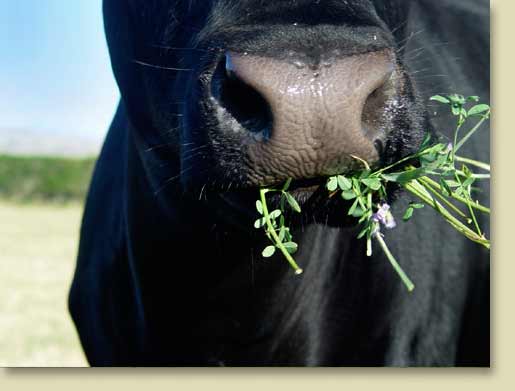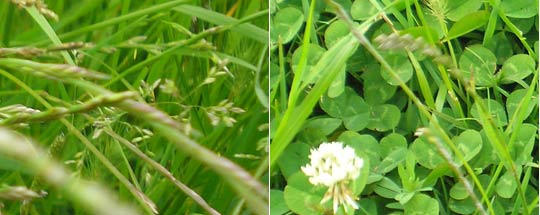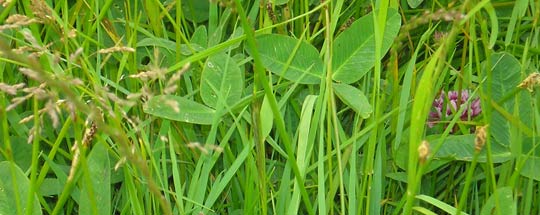
Grass Fed Health Benefits
"Nutrient-rich beef, more essential Omega-3s..."

Diet has a profound effect on the health of an animal and the meat it produces.
Grazed year-round on lush, green, pesticide-free pasture land, Pacific Pastures cattle produce meat with more nutrients and less fat than conventional beef.
Their high quality forage and life outdoors lead to a leaner, more flavorful beef with two to six times more of a type of "good" fat called "omega-3 fatty acids" as well as more of the vitamins E, C and Beta-Carotene.

Above left, rye grass growing in one of our pastures with clover on the right

Above, a healthy mix of rye grass and clover growing in another pasture
Best selling author, Jo Robinson, explains the benefits of grass fed meat in her book, Why Grassfed Is Best! The Surprising Benefits of Grassfed Meats, Eggs, and Dairy Products.
Following are some of the points Robinson makes in her book with references listed below:
- Grassfed meat has about the same amount of fat as skinless chicken or wild deer or elk.–1
- When meat is this lean, it actually lowers your LDL cholesterol levels.–2
- Leaner meat is also lower in calories.
- Although grassfed meat is low in "bad" fat (including saturated fat), it gives you from two to six times more of a type of "good" fat called "omega-3 fatty acids."
- Omega-3 fatty acids play a vital role in every cell and system in your body. For example, of all the fats, they are the most "heart friendly." People who have ample amounts of omega-3s in their diet are less likely to have high blood pressure or an irregular heartbeat. Remarkably, they are 50 percent less likely to have a serious heart attack.–3
- Omega-3s are essential for your brain as well. People with a diet rich in omega-3s are less likely to be afflicted with depression, schizophrenia, attention deficit disorder (hyperactivity), or Alzheimer's disease.–4
Omega-3s may reduce your risk of cancer. The reason that grassfed animals have more omega-3s than grainfed animals is that omega-3s are formed in the chloroplasts of green leaves of plants. Sixty percent of the fat content of grass is a type of omega-3 fatty acid called alpha-linolenic or LNA. - Switching our livestock from their natural diet of grass to large amounts of grain is one of the reasons our modern diet is deficient in these essential fats. It has been estimated that only 40 percent of Americans consume a sufficient supply of these nutrients. Twenty percent have levels so low that they cannot be detected.–11
- Switching to grassfed animal products is one way to restore Omega-3s to your diet.
- The CLA Bonus: The meat and milk from grassfed ruminants are the richest known source of another type of good fat called "conjugated linoleic acid" or CLA. When ruminants are raised on fresh pasture alone, their milk and meat contain as much as five times more CLA than products from animals fed conventional diets.–12
- CLA could be a powerful defense against cancer. In addition to being higher in omega-3s and CLA, meat from grassfed animals is higher in vitamin E. In humans, vitamin E is linked with a lower risk of heart disease and cancer. This potent antioxidant may also have anti-aging properties. Most Americans are deficient in vitamin E.
Please visit NY Times best selling author Jo Robinson's website for extensive information on grassfed meat and to purchase her books.
References
1. Fukumoto, G. K., Y.S. Kim, D. Oduda, H. Ako (1995). "Chemical composition and shear force requirement of loin eye muscle of young, forage-fed steers." Research Extension Series 161: 1-5. Koizumi, I., Y. Suzuki, et al. (1991). "Studies on the fatty acid composition of intramuscular lipids of cattle, pigs and birds." J Nutr Sci Vitaminol (Tokyo) 37(6): 545-54.
2. Davidson, M. H., D. Hunninghake, et al. (1999). "Comparison of the effects of lean red meat vs lean white meat on serum lipid levels among free-living persons with hypercholesterolemia: a long-term, randomized clinical trial." Arch Intern Med 159(12): 1331-8. The conclusion of this study: "... diets containing primarily lean red meat or lean white meat produced similar reductions in LDL cholesterol and elevations in HDL cholesterol, which were maintained throughout the 36 weeks of treatment."
3. Siscovick, D. S., T. E. Raghunathan, et al. (1995). "Dietary Intake and Cell Membrane Levels of Long-Chain n-3 Polyunsaturated Fatty Acids and the Risk of Primary Cardiac Arrest." JAMA 274(17): 1363-1367.
4. Simopolous, A. P. and Jo Robinson (1999). The Omega Diet. New York, HarperCollins. My previous book, a collaboration with Dr. Artemis P. Simopoulos, devotes an entire chapter to the vital role that omega-3s play in brain function.
11. Dolecek, T. A. and G. Grandits (1991). "Dietary Polyunsaturated Fatty Acids and Mortality in the Multiple Risk Factor Intervention Trial (MRFIT)." World Rev Nutr Diet 66: 205-16.
12. Dhiman, T. R., G. R. Anand, et al. (1999). "Conjugated linoleic acid content of milk from cows fed different diets." J Dairy Sci 82(10): 2146-56. Interestingly, when the pasture was machine-harvested and then fed to the animals as hay, the cows produced far less CLA than when they were grazing on that pasture, even though the hay was made from the very same grass. The fat that the animals use to produce CLA is oxidized during the wilting, drying process. For maximum CLA, animals need to be grazing living pasture.
Contact us for questions or feedback.



